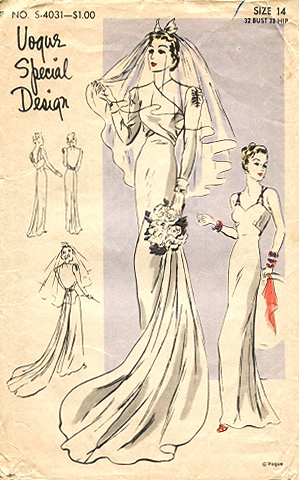Vintage patterns are tres chic right now. If you're intrigued with past patterns and plan on finding a designer/seamstress who can whip up your creation, here are a few things you should know. Unlike today's patterns that include many sizes in one package, those from yesteryear are a one size only deal. Not only are silhouettes reminiscent of an era, did you know overall cut, types of darts and dart lines are as well? With all the changes in machinery over the last thirty plus years as well as hemming products, range of notions available and faster techniques, whoever is making your dress will have to know how to adapt instructions provided by the original pattern.
1920s
Want to do a Gatsby or roaring twenties theme? The 1920s was about women's freedom and it played itself out most dramatically in fashion. It was one of the first times in history the female body was comfortable. Typically wedding dresses were short with loads of lace and a graduated hemline forming a train in back. Most headpieces were cloche-like and worn low on the forehead. The above pattern is for an informal affair . . .
True bias cut, body-hugging, gowns made their way into bridal wear in lightweight satins and crepes. Hollywood had a great influence on fashion during this time and many brides to be looked to the cinema for inspiration. This is also the era Brides magazine premiered its first issues, not only featuring gowns and veils but ideas for trousseau and setting up home as well.
1940s
Alines with sweetheart necklines and puffed sleeves in bridal satin were typical till wartime when fabric was rationed. During wartime, brides married quickly before sending lovers off to war. Often they'd marry in their best dress or more often, best suit. Once restrictions were lifted on fabric after the war, even wider poufier skirts returned . . .
1950s
The era of Christian Dior was all about yards of skirt and nipped in waists. Slimmer silhouettes celebrated the female form as well. Synthetic fabrics were all the rage, even in bridal wear. Many dresses that have survived this era either home made or manufactured are rayon, acetate or Dacron. No Polyester; that was the miracle synthetic of the 1960s . . .
1960s
The early sixties of Audrey Hepburn and Jackie Kennedy's influence on fashion was radically different from the Mod swinging late sixties. The styles on the above right pattern envelope show a Mary-Jane and lace child-bride look so prevalent in fashion by the youthquake years . . .
1970s
Though this was an era of funky fashion we were still stuck with the cookie-cutter bridal image like the one above. Nina Ricci did great with this bride's boho veil and headpiece though and the lines of the dress are flattering. What we lacked then that we have now is brides brave enough to step outside the box and do something really earthshaking . . .
1980s
Yuck! Okay so I shouldn't be so judgmental especially since this is the era I began designing in, that of pouf and paste, millions of glued on sequins and overdone puffy veils. And the ones in the images above are the tamer versions done by Vogue. You shoulda seen the schlock out on the racks back then. The result was, most brides looked consumed under all the layers of frippery . . .
But . . . this was the look
If you're imaginative, you know you don't necessarily need a pattern that says, bridal on it or have a dress pictured in white. Any design or color shown can be created as a wedding dress.
A last word here. I don't believe in the theory bodies change from era to era but I believe foundations do. In the twenties women wore binders to flatten their boobs into chests; in the fifties rubberized armor-like girdles and long-lined bras to achieve a Dioresque ideal. Studying the underwear of the decade you're going for could be very helpful






































